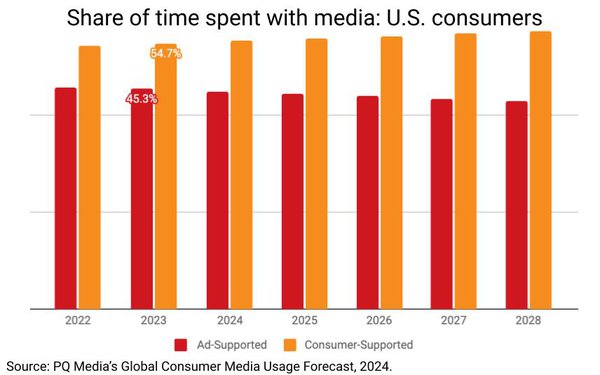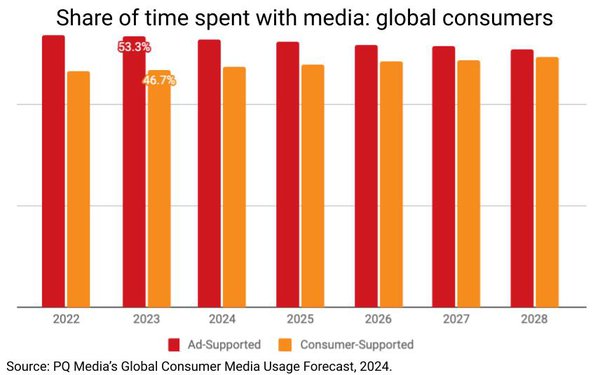U.S. Consumer Time Spent With Media Fell For First Time In 2023
- by Joe Mandese @mp_joemandese, May 1, 2024

The good news -- or bad news, depending on how you look
at it -- is that consumer time spent with media continues to expand. The really bad news for the ad industry is that ad-supported media's share continues to decline, in both the U.S. and
worldwide.
Those are among the findings in the 2024 edition of an annual Global Consumer Media Usage Forecast released this morning by PQ Media.
While total weekly time spent with media actually declined 0.4% to 76.69 hours in the U.S., and inched up only 0.3% to 56.15 hours worldwide, PQ forecasts it will rebound again this year and continue expanding for the foreseeable future.
“[Media consumption] will post accelerated growth in 2024 with general elections in the United States, Mexico, Japan, Taiwan, India and South Africa, as well as the Summer Olympics in Paris, that will drive media usage rates in most of Western Europe that are in the same time zone or within an hour,” says PQ Media CEO Patrick Quinn. “In 2026, we’ll see this same phenomenon in the Americas when the United States, Mexico and Canada tri-host the FIFA World Cup and, again, in 2028 when the Summer Olympics are held in Los Angeles.”
In terms of ad-supported media's share of time spent, the U.S. reached the tipping point in 2015, when consumer-supported media became the dominant sources for American consumers.
For the global consumer media marketplace, ad-supported media will continue to have the dominant share through 2028, but it also is on a trajectory to tip sometime shortly after that.




Joe, once again, I must point out that the ad-supported definition used is based on the proportion of support that comes from ads versus subscriptions, and does not tell you what percentage of all media usage features ads.
As I understand the stats, if a medium obtains 49% of its revenues from ads and 51% from subscriptions, it would be classified as "consumer supported". But it still sells ads and these are exposed to its audience.
Actually, the vast majority of media time presents ad messages---the major exception being SVOD and digital venues. The rise of SVOD is the main factor that is causing a decline in the availability of "TV" GRPs, however the influx of FASTs and AVODs in the slowly expanding streaming space may soon counter the loss of GRPs by Pay TV due to cord cutting. This will be especially true as the AVODs and FASTs begin to increase their commercial loads in an effort to become profitable.
@Ed Papazian: Here's PQ Media's definition:
"Ad-supported media are considered to be those platforms that generate over half of its revenues from advertising, while conversely consumer-supported media are considered to be those platforms that generate over half of its revenues from consumer spending on media. The lines have blurred, such as newspaper advertising cratering over the last decade, while circulation declines less deep; while most of mobile and internet spend was generated by consumer spend on access (broadband, wi-fi, etc.) versus the advertising behemoths that Facebook and YouTube have become."
Readers should interpret that however they want, but it's a definiiton that has been used conistently for decades -- including by Veronis, Suhler & Associates before PQ Media -- to plot the shift in media economic models over time.
The truth is many media have multiple revenue streams these days, and always have.
The analysis is a way to look at where the perponderance is coming from.